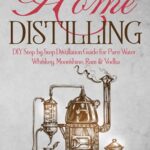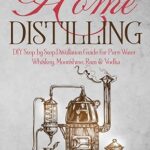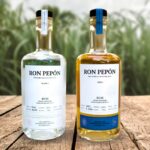A Radical Distillation
On April 19, 2022 began on ZAVVY a livestream of the program “Aquí se habla de ron”, hosted by Fede J. Hernández, entrepreneur specialized in sales and marketing, Jaiker Soto, chemical engineer expert in the distillation and fermentation process, Ramon Almao, founder of Rum & Spirits and as a guest of the program is Dick Barba, founder of Radical Spirits. He will be talking about his brand of Panamanian rum Manigordo.
History of Dick Barba in the Spirits Industry
Dick Barba, the founder of Radical Spirits, has a rich history in the rum industry. His journey began in 2002 at Flor de Caña, where he worked on a biogas production project using distillery vinasse. This was his first encounter with molasses fermentation and continuous distillation columns, producing about 160,000 liters of rum daily. This experience sparked his passion for rum.
In 2005, the owners of Flor de Caña, who also owned the sugar mill, began a project to produce fuel alcohol. Barba had the privilege of moving to this new distillery and even coordinated the design of the new fermentation plant. They explored mixing cane juice with honey to produce fuel alcohol.
In late 2009, Barba received an irresistible job offer in the Dominican Republic and became the production manager of Alcoholes Finos Dominicano. This distillery supplies rum for the well-known Dominican brand Ron Barceló.
In addition to his work at Radical Spirits, Barba also served as the production head at Ron Barceló from 2010 to 2012. He then moved on to work with Diageo Latin America as a distillation specialist from 2013 to 2017.
Radical Spirits is a small artisanal rum company located in the heart of one of Panama’s most beautiful regions, Chiriquí. With over 20 years in the rum industry, Dick Barba’s deep interest and passion for rum continue to grow.
Dick Barba: Expanding Horizons in the Rum Industry
Dick Barba’s journey in the rum industry continued in the Dominican Republic, where he worked at a distillery that produced 50,000 liters of alcohol daily from cane juice. The distillery complex included a milling section that processed 800 tons of cane per day. They used bagasse to produce steam in a high-pressure boiler and generate electricity in a pair of two-megawatt turbines. Initially intended to be continuous, the fermentation process had to be converted to batch due to technical details. This experience allowed Barba to learn new things about milling and high-pressure steam generation for feeding turbines.
While in the Dominican Republic, Barba had the opportunity to work as a distillation specialist for Diageo Latin America. This role allowed him to interact with marketing and logistics professionals and get involved in new product development and aging projects. He also worked with other distilled spirits categories such as Tequila in Mexico with Don Julio and Tequila de León, and with Ipoca in Brazil to optimize the distillery operation for cachaza production.
Barba continued his work on rum projects in the Virgin Islands with Captain Morgan, in Venezuela with Pampero and Cacique aging projects, and in Guatemala with Zacapa. He was fortunate to work alongside renowned Master Blenders like Caroline Martin from Scotland, Luis Figueroa from Venezuela, and Lorena Vázquez from Zacapa.
Dick Barba’s Transition: From Diageo to the Creation of an Artisan Rum in Panama
Dick Barba, embarked on a journey that began with his work at Diageo. His interest in rum production was sparked during his tenure there, leading him to make the difficult decision to leave Diageo in 2017. He accepted a role with Lallemand, an international company that produces yeast for beer, wine, and spirits, with the intention of dedicating himself to rum production.
In 2017, Barba began experimenting with molasses and acquired a ten-liter copper still to understand the impact of distillation. His interest in traditional batch distillation using a copper still grew after experiencing the evident difference between continuous column rum and copper still rum.
During a supermarket visit searching for molasses for his experiments, Barba stumbled upon a package of artisanal honey from Chiriquí. The quality and complexity of the liquid impressed him so much that he immediately contacted the owner of the panela factory that produced this honey. He proposed a business idea to produce rum, which was quickly accepted by Norberto, the owner of Panela de Oro.
By 2017, they had finalized plans and started purchasing equipment for production. By 2018, they had set up a pilot plant for initial rum testing. Barba brought in someone from Nicaragua who had worked with him at the Flor de Caña distillery to operate the new distillery.
The distillery is located in one of Panama’s most beautiful regions, at an altitude of about 1000 meters above sea level. The average temperature is around 20 degrees Celsius, making it an ideal location for rum production. With unique and interesting raw materials yielding good results and a copper still for distillation, they were all set to produce high-quality rum.
The Evolution of Radical Spirits: A Journey from Rum to Whisky
Traditionally, rum is aged in bourbon barrels, while whisky is a niche product that is not widely understood. However, Barba believed that whisky barrels could impart a distinctive touch to rum. In 2019, Radical Spirits launched its first product, a white rum, alongside a rum that Barba likens to a “reposado tequila” due to its one-year aging process in whisky barrels. This rum had a faint color but a distinct character that balanced the notes of the rum with the contributions of the whisky barrels.
In 2018, Barba relocated to Montreal, leaving the operations in the capable hands of a young distiller brought in from Nicaragua. Despite the challenges posed by the COVID-19 pandemic in 2020, Radical Spirits received positive feedback on their products and remained optimistic about their potential and prospects.
The company also experimented with directly aged rum juice, which was aged for three months in barrels that had previously contained their rum. This particular product received favorable reviews. Currently, Radical Spirits is in the process of developing more products and is particularly focused on aged rum. This year, they have enough liquid to launch an aged rum under a brand different from Gordo. With several interesting ideas in the pipeline, Radical Spirits continues to push boundaries in the spirits industry.
The Unique Conditions of Panama: A Haven for Rum Production
Dick Barba, set out to produce rum but found himself not only with a high-quality raw material – artisanal, pure honey with incredible qualities, but also a fantastic region with a unique climate. The temperature in this region is conducive to a different kind of aging than traditional rum, which is usually produced in very warm regions near the coasts.
In contrast to the distillery of Carta Vieja located near the city of David in the lower part of the region, which is very hot, this region experiences a cycle of extreme temperatures. The relatively low temperatures for a good part of the year help reduce the rate of evaporation compared to coastal regions.
Another favorable aspect of Panama is its rainfall. In the highlands of Chiriqui, it rains for nine out of twelve months, with only three months of summer when temperatures rise slightly. This results in unique humidity conditions.
Furthermore, the volcanic soil in this region is incredibly fertile. The extended hours of sunlight promote the growth of sugarcane, making it one of the few regions where sugarcane can be harvested all year round. This benefits Radical Spirits’ operation as they have access to fresh honey all year round, even though they primarily use honey in their production.
Radical Spirits: Upholding Artisanal Techniques in Rum Production
Dick Barba, the founder of Radical Spirits, emphasizes the importance of the artisanal techniques employed by the local farmers in the region. The production of their rums is considerably more expensive compared to industrial rums, primarily due to the scale of production and the cost of their raw material – honey, which is more expensive than molasses.
The farmers harvest the sugarcane and process the juice into honey using completely artisanal methods. Radical Spirits strives to pay a fair price for the honey to ensure that the farmers also receive a just benefit. The batch distillation operation and the specific type of barrels used for aging also add to their production costs.
Barba was particularly impressed by the care with which the farmers manage their fields and harvest the sugarcane to ensure year-round availability. Depending on the size of their farms, most farmers use a variety called ‘Crystal’. However, some knowledgeable farmers explore and combine other varieties according to their different terrains.
Mostly, farmers use bagasse to concentrate the juice. In their stills, Radical Spirits uses propane gas. Although they do not currently have a boiler to generate steam, it is part of their future vision. This commitment to artisanal techniques and fair trade practices underscores Radical Spirits’ dedication to producing high-quality rum.
Optimizing Honey Fermentation: A Case Study
Dick Barba, an expert in the field, shared his insights on the utilization of honey in fermentation processes. Unlike molasses, honey allows for a fermentation level of up to 16%. The technique employed by Barba and his team is a stage-wise feeding of honey during the process. This method ensures that the yeast can appropriately manage the load of dissolved solids without undue stress, thereby completing the fermentation process effectively.
The Brix degree, a measure of the sugar content in an aqueous solution, typically ranges from 16 to 18. However, the honey brought to their distillery farm reaches up to 72 Brix. The team possesses the skill to estimate the Brix degree of the honey just by sight.
This approach not only maximizes the use of honey but also contributes to a more efficient and stress-free fermentation process.
Enhancing Aromatic Character in Rums
According to Dick Barba, the fermentation process typically completes within four to five days. However, they allow a couple of extra days for the reabsorption. This additional time contributes to the development of a higher quantity of congeners during fermentation, which imparts an aromatic character to the product before it goes to the still.
The reabsorption of Diacetyl and the increase in the concentration of organic acids facilitate a higher formation of esters. This occurs without the need for distillation and results in natural ester formation during fermentation.This process gives their rums an extraordinarily unique character, demonstrating the art and science behind their fermentation techniques.
Yeast Strains in Fermentation: A Game Changer in Flavor Profile
Dick Barba, expressed his belief in the significant impact different yeast strains can have on fermentation. Despite some skepticism in the industry, Barba is convinced of the distinct differences between various strains.
His team has experimented with several strains and currently utilizes two strains of Saccharomyces cerevisiae from Germany. They believe that these strains contribute unique characteristics to their product. It is a well-established fact that different yeasts produce different congeners, even when fermentation conditions remain constant.
Among the two strains they use, one is relatively neutral but highly efficient in high production. This approach underscores their commitment to exploring and harnessing the potential of yeast diversity in creating distinctive products.
Expansion of Distillery Operation
Dick Barba’s distillery operation is currently small-scale, with an installed capacity of 8,000 boxes per year. However, there are plans to double this capacity by the end of the year. The distillery uses uniquely shaped stills, featuring an onion-like body and a conical top. A slight modification has been made to the swan neck of the still to allow for better separation of heavy alcohols and increase reflux.
The distillation process is carried out in two stages. The first stage produces low wines with an alcohol content of around 38-40%. These low wines are then sent for a second distillation. The resulting rum from this second distillation averages around 70% alcohol.
The use of 40% alcohol in the low wines allows for a cleaner second distillation compared to one with 25 or 28% alcohol. This also enables higher production with smaller equipment. With just 16% alcohol, the distillery can achieve almost 100% difference compared to wines with 8 or 10% alcohol.
Dick Barba’s Distillery Process
Dick Barba’s distillery has experimented with various dilutions for barrel aging, ranging from 55% to 70%. After analyzing the resulting spirits, they decided to set their average at 62%. They believe this is where they capture the best balance between the wood and the character of the distillates.
The distillery uses a variety of barrels for aging, including rey, bourbon, and fresh barrels. They then blend these spirits. Their aged rum, which will be released this year, is three years old. Despite its youth, it has a lot of character because the barrels used are fresh, meaning they have only been used once for whiskey, either rye or bourbon.
A percentage of new barrels contributes more vanilla and color naturally. From the outset, they decided not to add anything to the rum in order to capture the essence of what they were doing. To preserve the integrity of their fermentation, distillation, and barrel processes, they decided not to add any rounding agents or sugar, and they do not add color either.
While caramel is widely used in the industry and there is nothing wrong with its use for adjusting natural variations between batches and maintaining a consistent color, it can be misused in some cases to give consumers the impression that they are purchasing a very aged product. Dick Barba’s distillery wanted to distance itself from this practice and present consumers with a product exactly as it comes out of the barrel without any editing.
The Story of Manigordo Rum
Dick Barba, the creator of Manigordo, shared the story behind the unique name and the distinct flavor profile of their rum. The name ‘Manigordo’ was chosen after much deliberation. It was inspired by the region where the distillery is located, which is home to many ocelots, locally known as ‘manigoldo’ due to their large front paws.
Manigordo Rum is a unique blend that lies somewhere between a molasses rum and a juice rum. It is made from syrup or concentrated cane juice, resulting in some caramelization but without any salts like in molasses. In Barba’s opinion, the character of Manigordo Rum leans more towards a juice rum than a molasses rum.
The distillation process imparts a variety of fruity notes to the rum, with banana and citrus being particularly prominent. The influence of the raw material is so strong that one’s first impression upon tasting it is that it is derived from cane. However, citrus notes and fruity aromas are more dominant.
Manigordo Rum is definitely more characterful than traditional white rums made in distillation columns. The white variant has an alcohol content of 40%, which is interesting because the palate in Panama is more accustomed to a 37.5% alcohol content. The difference may seem small, but it is quite perceptible. In fact, it is traditional in Panama for rums to have an alcohol content between 35% and 37.5%.
The Journey of Manigordo Rum: A Young Spirit with a Whisky Twist
Dick Barba, the creator of Manigordo Rum, describes it as a young rum. The term “añejo” cannot be applied to it due to its relatively short maturation period. Despite this, the rum has received positive feedback from consumers, many of whom associate its flavor profile with whisky rather than traditional rum.
Manigordo Rum is characterized by notes of vanilla and spices, which are typically associated with whisky. This is not surprising given Barba’s personal inclination towards whisky. His fondness for whisky influenced the creation of Manigordo Rum, resulting in a spirit that is both unique and personal.
The feedback from consumers has been encouraging, with many expressing a desire for an aged version of Manigordo Rum. In response to this demand, a limited edition aged variant was released under a different name. This two-and-a-half-year-old version was well-received and quickly sold out.
When served on the rocks, the whisky notes in this aged variant were more pronounced, followed by the fruity notes and cane aroma characteristic of rum. Despite its youth, Manigordo Rum has managed to carve out its own niche in the market with its unique flavor profile and distinct character.





